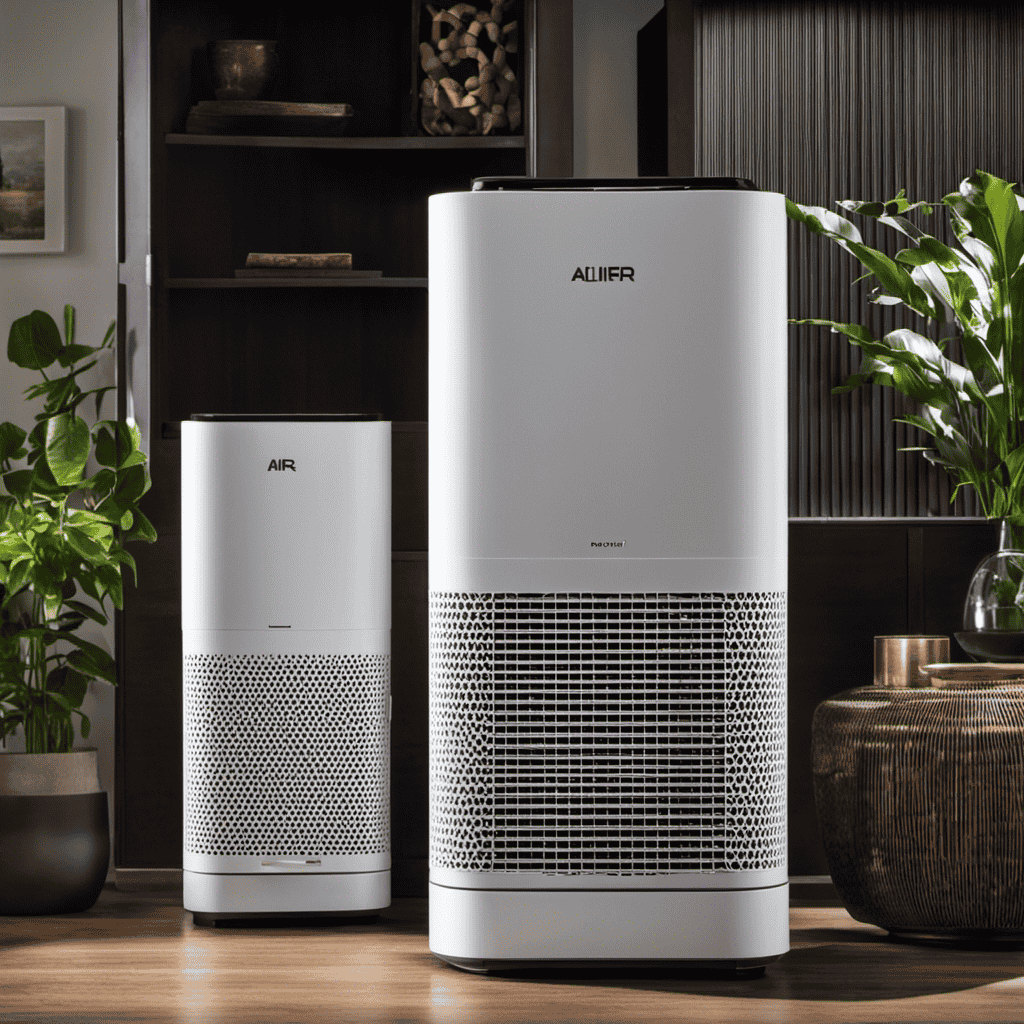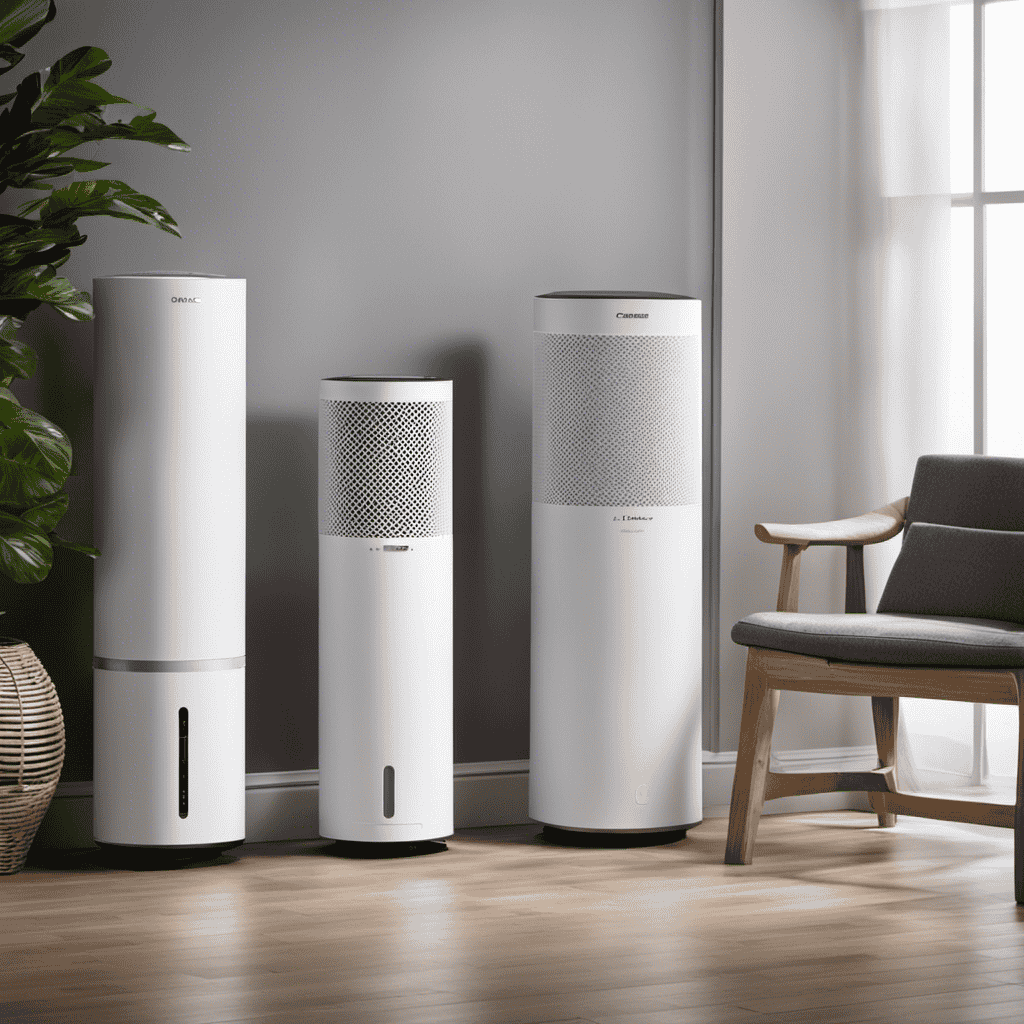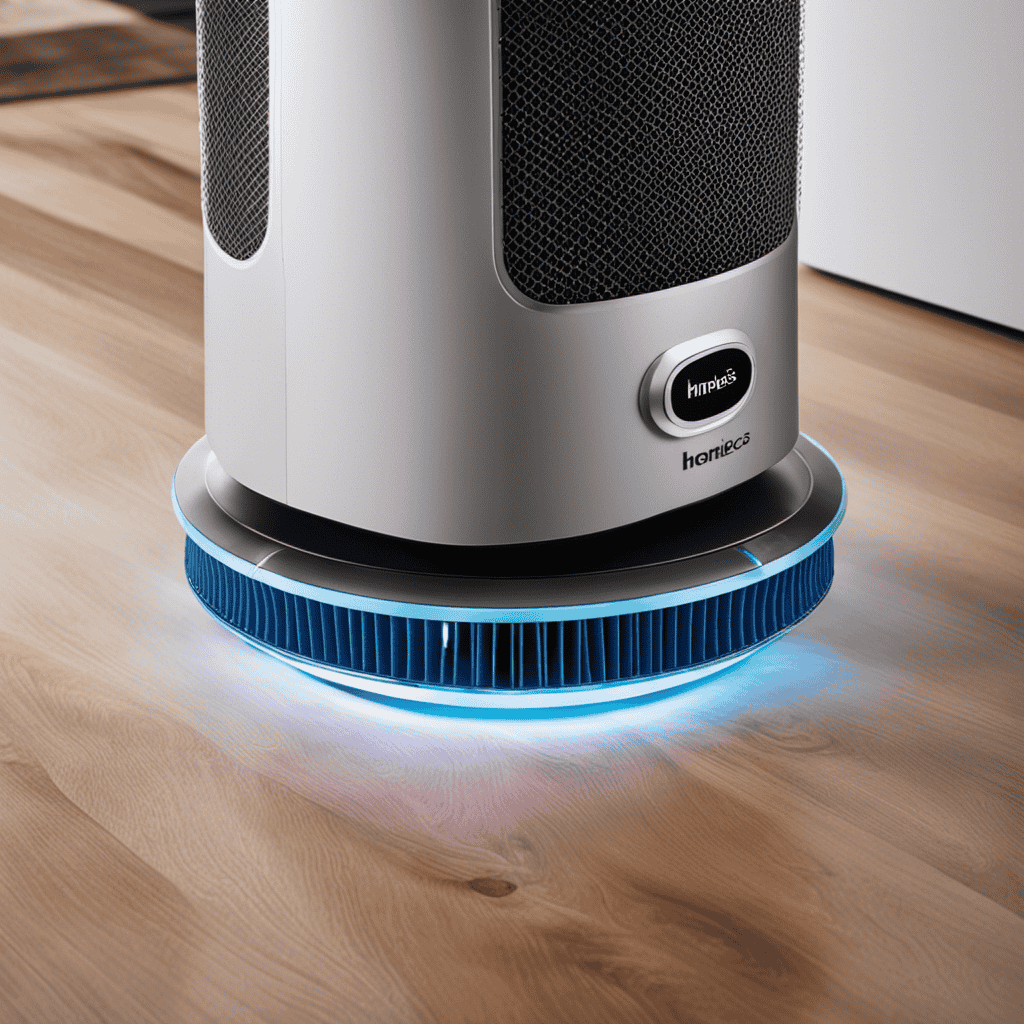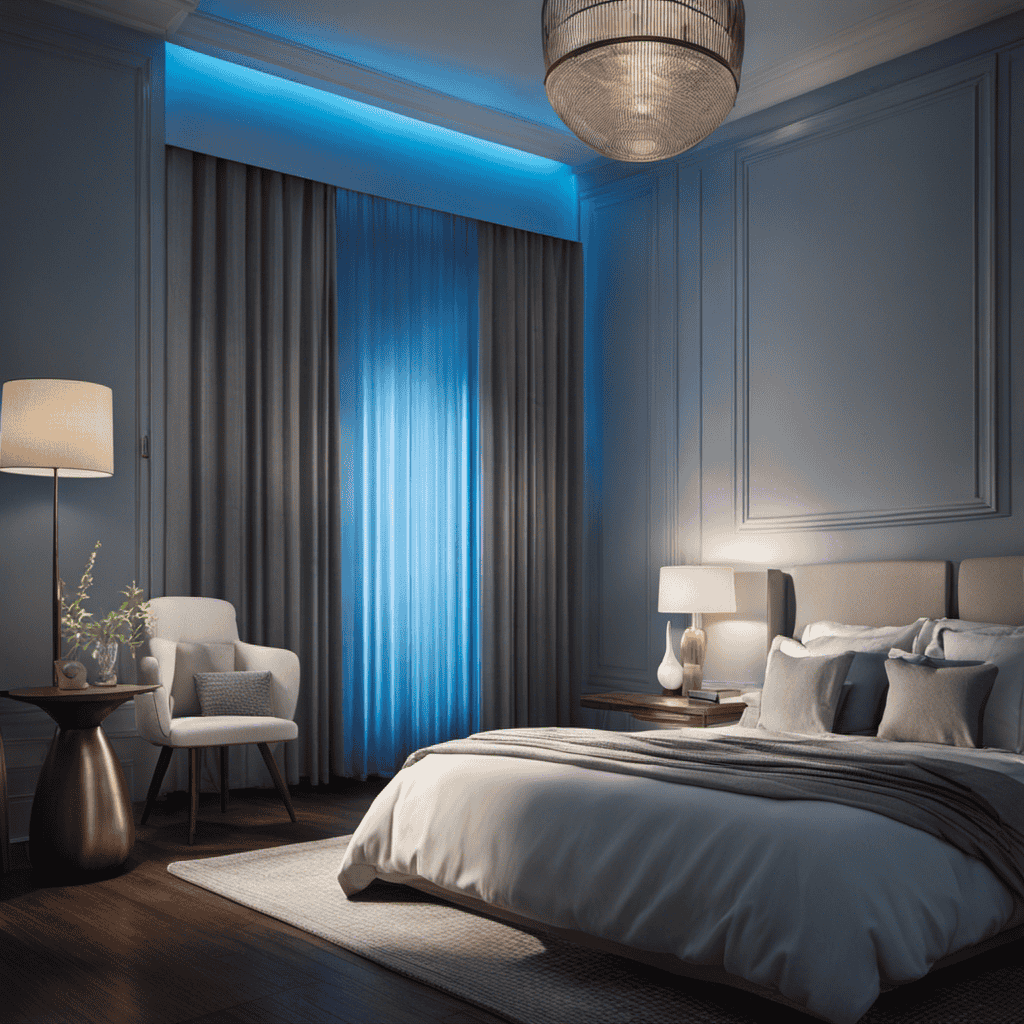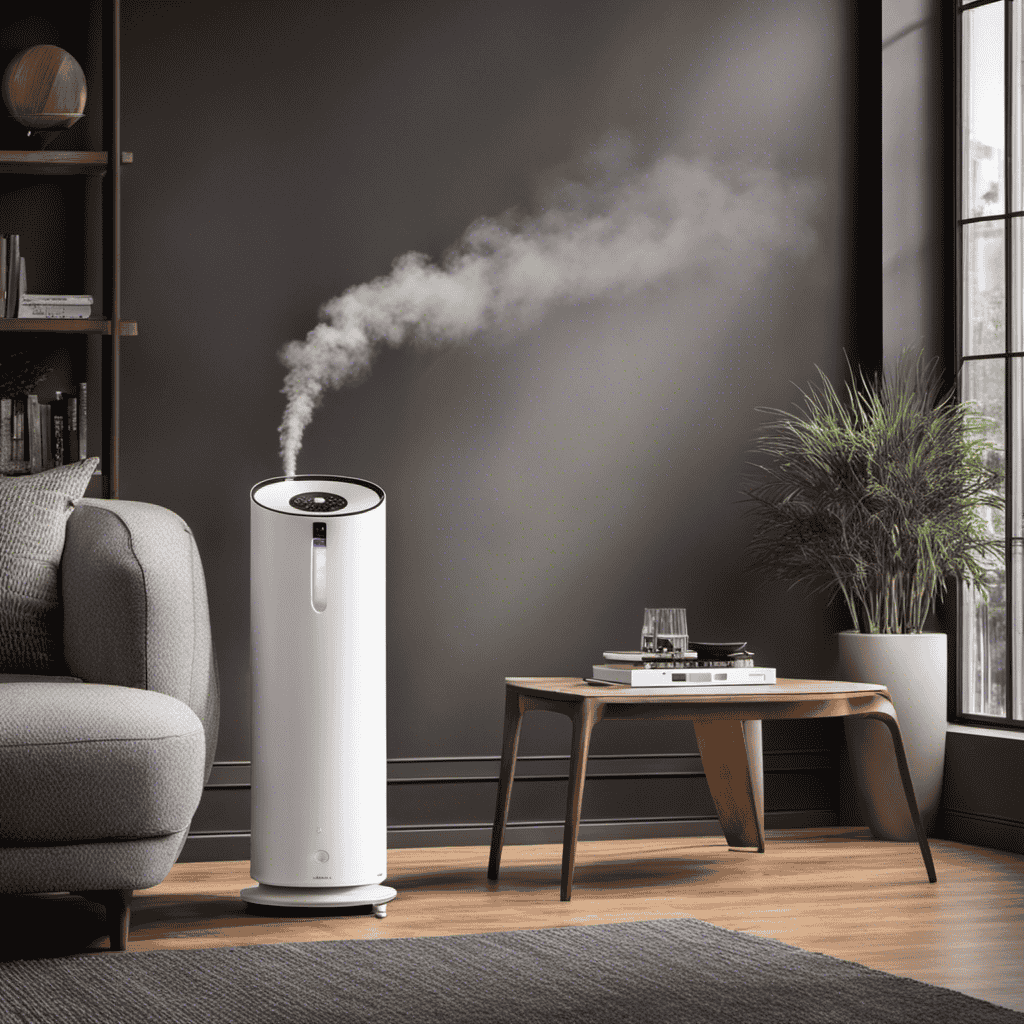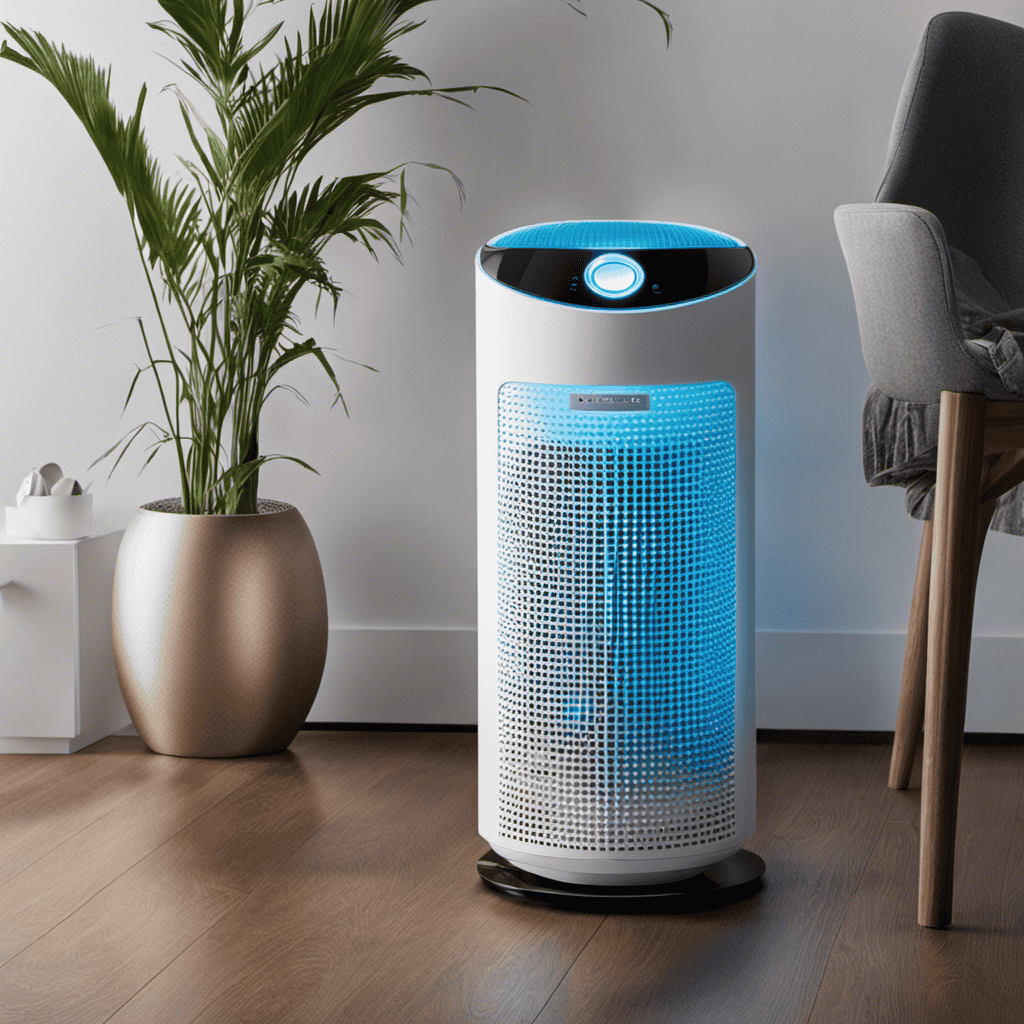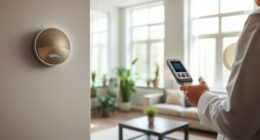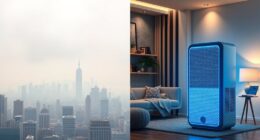As a homeowner, I frequently liken my air purifier filter to a shield, constantly defending me from the unseen foes that linger in the air. However, similar to any shield, it will eventually deteriorate and require replacement.
In this article, we will explore the factors that determine the frequency of air purifier filter replacement, the different types of filters and their lifespan, as well as the recommended intervals by manufacturers.
So let’s dive in and ensure we’re breathing clean and fresh air every day.
Key Takeaways
- Different air purifiers have varying filter lifespans.
- Regular maintenance can help extend the lifespan of the filter.
- The optimal pre-filter lifespan varies based on air pollution levels and usage.
- The signs that indicate the need for filter replacement include visible dirt or debris on the filter surface, increased dust accumulation in your home, worsening allergy or asthma symptoms, lingering unpleasant odors in the air, and reduced effectiveness of the air purifier in capturing particles.
Factors That Determine Filter Replacement Frequency
You should consider factors such as the air quality in your home and the manufacturer’s recommendations to determine how often you need to replace your air purifier filter.
The recommended replacement schedule for air purifier filters can vary depending on these factors. Air quality plays a significant role in determining filter lifespan. If you live in an area with high levels of pollution or allergens, your filter may need to be replaced more frequently. Additionally, factors like pet dander, smoking, and cooking can also contribute to a shorter filter lifespan.
It is important to follow the manufacturer’s recommendations as they have tested their products and can provide specific guidelines based on the filter’s efficiency and usage.
Regularly replacing your air purifier filter ensures optimal performance and helps maintain clean and healthy indoor air.
Types of Air Purifier Filters and Their Lifespan
When it comes to different types of air purifier filters, it’s important to be aware of their lifespan. Understanding how long each type of filter lasts can help you plan your maintenance routine and ensure that your air purifier is functioning optimally.
Here are some popular types of air purifier filters and their typical lifespan:
-
HEPA Filters: These filters are highly efficient in removing small particles from the air, such as dust, pollen, and pet dander. On average, HEPA filters have a lifespan of about 6 to 12 months.
-
Carbon Filters: These filters are effective in removing odors and chemicals from the air. They typically last for 3 to 6 months, depending on the level of pollutants in your environment.
-
Pre-Filters: These filters capture larger particles, such as dust and hair, before they reach the main filter. Pre-filters usually last for 1 to 3 months.
-
Electrostatic Filters: These filters use an electric charge to capture particles and can last for several years with regular maintenance.
-
UV Filters: These filters use ultraviolet light to kill bacteria and viruses. They have a long lifespan and generally do not need to be replaced unless they become damaged.
To extend the lifespan of your air purifier filters, here are some maintenance techniques you can follow:
-
Regularly clean or replace pre-filters to prevent them from clogging and reducing the efficiency of the main filter.
-
Vacuum or gently brush off dust and debris from the surface of the filters to maintain their effectiveness.
-
Follow the manufacturer’s instructions for cleaning and replacing filters to ensure optimal performance.
-
Keep your air purifier in a clean environment to reduce the amount of pollutants that the filters need to remove.
-
Monitor the air quality in your home and adjust the usage of your air purifier accordingly to minimize unnecessary wear on the filters.
Recommended Filter Replacement Intervals by Manufacturers
When it comes to maintaining the effectiveness of an air purifier, following the manufacturer’s recommended filter replacement intervals is crucial. These intervals are determined based on factors such as the type of filter and the air quality in your home.
Manufacturer’s Recommended Intervals
The manufacturer’s recommended intervals for replacing the air purifier filter depend on usage and air quality. To ensure optimal performance and clean air, it is crucial to follow these filter replacement recommendations:
-
Frequency of use: If you use your air purifier constantly, the filter may need to be replaced more frequently compared to occasional use.
-
Air quality: If you live in an area with poor air quality, the filter may get clogged quicker and require more frequent replacements.
-
Filter type: Different types of filters have varying lifespans. HEPA filters typically last longer, while carbon filters may need more frequent replacements.
-
Environmental factors: Dusty environments or homes with pets may require more frequent filter changes.
-
Filter maintenance: Regularly cleaning and maintaining the filter can extend its lifespan and reduce the need for frequent replacements.
Filter Replacement Frequency
To keep your indoor air clean and fresh, remember to regularly check and replace the filter. The frequency of filter replacement depends on various factors affecting its lifespan.
These factors include the type of filter, the air quality in your home, and the usage of the air purifier. High-quality filters typically last longer than lower quality ones. Additionally, if you have pets or live in a highly polluted area, the filter may get clogged more quickly and require more frequent replacement.
Regularly replacing the filter has several benefits. It ensures that your air purifier functions at its best, removing pollutants effectively. It also helps maintain good indoor air quality, reducing the risk of allergies and respiratory issues.
Signs That Indicate the Need for a Filter Replacement
If you notice decreased airflow or a musty odor, it might be time to replace your air purifier filter. Regular filter replacement is essential for maintaining optimal air quality in your home.
Here are some signs that indicate the need for a filter replacement:
- Visible dirt or debris on the filter surface
- Increased dust accumulation in your home
- Allergy or asthma symptoms worsening
- Unpleasant odors lingering in the air
- Reduced effectiveness of the air purifier in capturing particles
Filter replacement indicators, such as a filter replacement light or timer, can help remind you when it’s time to change the filter. Additionally, you can prolong the lifespan of your filter by regularly vacuuming or washing it, depending on the type of filter.
How Often to Replace HEPA Filters
When it comes to air purifiers, understanding the frequency of filter replacement and recognizing signs of filter degradation is crucial for maintaining optimal indoor air quality.
Knowing how often to replace the filters ensures that the air purifier continues to effectively remove pollutants and allergens from the air.
Additionally, being able to identify signs of filter degradation allows for timely replacement, preventing the filters from becoming a source of contamination.
Filter Replacement Frequency
You should check the manufacturer’s instructions for the recommended frequency of replacing your air purifier filter. It is important to follow these guidelines to ensure that your air purifier is functioning efficiently and effectively. Here are some key things to consider when it comes to filter replacement:
-
Recommended filter brands: Look for reputable brands that are known for producing high-quality filters. Some popular options include HEPA filters from brands like Honeywell, Blueair, and Coway.
-
Cost-effective filter replacements: Consider the cost of replacement filters when purchasing an air purifier. Look for filters that are reasonably priced and offer good value for money without compromising on quality.
-
Filter lifespan: Different air purifiers have different filter lifespans, so it’s important to know how long your specific model’s filter is designed to last.
-
Air quality: The frequency of filter replacement may vary depending on the air quality in your environment. If you live in an area with high levels of pollution or allergens, you may need to replace your filter more frequently.
-
Filter maintenance: Regularly cleaning and maintaining your filter can help extend its lifespan and improve its efficiency.
Signs of Filter Degradation?
In addition to understanding the frequency of filter replacement, it is equally important to be aware of signs that indicate filter degradation. Regular filter maintenance is crucial for prolonging the filter lifespan and ensuring optimal air purification.
Over time, filters accumulate dirt, dust, and other particles, causing them to become clogged and less effective. One common sign of filter degradation is a noticeable decrease in the air purifier’s performance. If you notice that the air quality in your space has worsened or that the unit is struggling to effectively remove pollutants, it may be time to clean or replace the filter.
Additionally, a visual inspection of the filter can reveal signs of deterioration, such as discoloration or damage. Regularly maintaining and replacing air purifier filters will help them function at their best and improve the overall indoor air quality.
Understanding Pre-Filters and Their Replacement Schedule
The pre-filter is an essential component of the air purifier, and it’s important to understand its replacement schedule. The pre-filter acts as the first line of defense, capturing large particles like dust, pet hair, and pollen, before the air passes through the main filter.
Here are five key points to consider:
-
Optimal pre-filter lifespan: The lifespan of a pre-filter varies depending on factors such as the level of air pollution in your area and the frequency of use. On average, it is recommended to replace the pre-filter every three to six months.
-
Improved air quality: Regularly replacing the pre-filter ensures that it continues to efficiently capture large particles, maintaining optimal air quality in your home or office.
-
Prolonged main filter lifespan: By capturing larger particles, the pre-filter helps to extend the lifespan of the main filter, reducing the frequency of main filter replacements.
-
Energy efficiency: A clean pre-filter allows for better airflow, reducing strain on the air purifier’s motor and improving energy efficiency.
-
Cost savings: Regular pre-filter replacement can save you money in the long run by preventing the need for expensive repairs or premature replacement of the entire unit.
Understanding the importance of the pre-filter and following its recommended replacement schedule is crucial for maximizing the benefits of your air purifier and maintaining clean and healthy indoor air.
Filter Replacement Frequency for Carbon Filters
When it comes to optimal filter changing and extending the lifespan of carbon filters, there are several key points to consider.
First, it’s important to understand the recommended replacement frequency for carbon filters, as this can vary depending on the specific air purifier and usage conditions.
Additionally, there are strategies and techniques that can be implemented to help prolong the lifespan of carbon filters. These include regular maintenance and proper cleaning methods.
Optimal Filter Changing
For optimal filter changing, it’s important to follow the manufacturer’s recommendations. To ensure optimal filter efficiency and prolong the filter lifespan, consider the following:
- Regularly check the filter for dirt and debris buildup.
- Replace the filter when it becomes visibly dirty or clogged.
- Consider the air quality in your area and adjust the filter replacement frequency accordingly.
- Keep track of the filter’s usage time and replace it as recommended by the manufacturer.
- Follow proper maintenance procedures to maximize the filter’s lifespan.
By following these guidelines, you can ensure that your air purifier operates at its best and provides clean air for a longer period.
Now, let’s explore how you can extend the lifespan of carbon filters.
Extending Carbon Filter Lifespan
Now that we understand the optimal frequency for replacing air purifier filters, let’s explore techniques to extend the lifespan of carbon filters specifically. Carbon filters are effective at removing odors and harmful gases, but they tend to have a shorter lifespan compared to other types of filters. By implementing certain strategies, we can maximize their efficiency and prolong their usage.
One technique is using pre-filters, which capture larger particles before they reach the carbon filter, reducing its workload. Another method is regular cleaning or vacuuming of pre-filters and the carbon filter itself. This prevents the accumulation of dust and debris, allowing the filter to maintain its effectiveness for a longer time.
It’s also important to keep the air purifier in a clean environment, as excessive dust or pet dander can clog the filter faster. Lastly, avoiding strong chemicals or high humidity levels can help preserve the carbon filter’s efficiency.
Implementing these filter lifespan extension techniques can significantly extend the effectiveness of carbon filters, saving both time and money in the long run.
| Filter Lifespan Extension Techniques | Benefits |
|---|---|
| Use pre-filters | Reduces workload on carbon filter |
| Regular cleaning | Prevents accumulation of dust and debris |
| Keep air purifier clean | Avoids clogging from excessive dust or pet dander |
| Avoid strong chemicals | Preserves carbon filter’s efficiency |
The Importance of Regular Filter Maintenance
Regular filter maintenance is crucial for optimal air purifier performance and clean air in your home. Neglecting filter maintenance can lead to decreased efficiency and increased filter replacement cost.
Here are the benefits of regular filter maintenance:
-
Improved air quality: By regularly cleaning or replacing your air purifier filter, you ensure that it effectively captures and removes airborne pollutants, allergens, and odors from your indoor air.
-
Enhanced performance: A clean filter allows your air purifier to work at its best, effectively circulating and filtering the air in your home.
-
Energy efficiency: A clogged or dirty filter can cause your air purifier to work harder, leading to increased energy consumption and higher utility bills.
-
Prolonged lifespan: Regular filter maintenance helps extend the lifespan of your air purifier by preventing excessive wear and tear on the system.
-
Cost savings: By maintaining your air purifier filter, you can avoid the need for frequent filter replacements, saving you money in the long run.
How to Extend the Lifespan of Your Air Purifier Filter
When it comes to extending the lifespan of your air purifier filter, there are several key points to consider.
First, understanding proper cleaning techniques for filters is crucial in maintaining their effectiveness.
Additionally, implementing effective maintenance strategies such as regular filter replacements and proper airflow management can significantly contribute to the longevity of your filter.
Lastly, taking preventative measures to avoid premature filter replacement, such as avoiding exposure to excessive pollutants or using a pre-filter, can help save both time and money in the long run.
Cleaning Techniques for Filters
To keep your air purifier filter clean and functioning properly, it is important to use gentle cleaning techniques. Here are some optimal cleaning techniques and filter maintenance tips:
-
Regular vacuuming: Use a vacuum cleaner with a brush attachment to remove dust and debris from the surface of the filter.
-
Washing with mild detergent: Some filters can be washed with a mild detergent and water. Follow the manufacturer’s instructions for proper cleaning.
-
Air drying: After washing the filter, allow it to air dry completely before reinstalling it in the air purifier.
-
Avoid harsh chemicals: Do not use any harsh chemicals or solvents to clean the filter as they may damage the filter material.
-
Replace when necessary: If the filter is damaged or heavily soiled, it may be time to replace it with a new one.
By following these optimal cleaning techniques and filter maintenance tips, you can ensure that your air purifier filter remains clean and efficient.
Now, let’s move on to effective maintenance strategies to further enhance the performance of your air purifier.
Effective Maintenance Strategies
Make sure you regularly check and clean the vents and fan blades of your air purifier to maintain its efficiency.
Optimal filter maintenance is crucial for maximizing the filter lifespan. Over time, dust and debris can accumulate on the vents and fan blades, obstructing the airflow and reducing the purifier’s effectiveness.
By regularly cleaning these components, you can ensure that the air purifier is operating at its optimal level. Cleaning the vents and fan blades also prevents the accumulation of dirt and dust on the filter, which can lead to premature clogging and the need for replacement.
Preventing Premature Filter Replacement
Regularly cleaning the vents and fan blades of your air purifier can help prevent the need for premature filter replacement. By incorporating these simple maintenance practices, you can extend the lifespan of your air purifier filter and save money in the long run.
Here are five common filter replacement mistakes to avoid:
- Neglecting regular cleaning and maintenance
- Using the wrong type of filter for your air purifier
- Not following the manufacturer’s recommended replacement schedule
- Failing to monitor the air quality in your home
- Overlooking the importance of proper ventilation
Factors That Can Influence Filter Lifespan
You should consider factors such as air quality, usage time, and the presence of pets when determining how often to replace your air purifier filter. These factors can greatly influence the lifespan of your filter.
If you live in an area with poor air quality, such as near a factory or in a city with high pollution levels, your filter may need to be replaced more frequently. Similarly, if you use your air purifier for extended periods of time or if you have pets that shed a lot of hair and dander, your filter may get clogged faster and require more frequent replacement.
To prolong the longevity of your filter, you can vacuum the pre-filter regularly and keep your home clean to minimize dust and allergens. Additionally, running your air purifier on a lower fan speed can also help extend its lifespan.
Filter Replacement Guidelines for Allergy Sufferers
If you’re an allergy sufferer, it’s important to consider the recommended guidelines for replacing your filter. Keeping your air purifier’s filter clean and fresh is crucial in maintaining optimal air quality and reducing allergens in your home.
Here are some filter replacement tips to help you breathe easier:
-
Follow the manufacturer’s recommendations: Check the user manual or the manufacturer’s website for the recommended filter replacement schedule specific to your air purifier model.
-
Monitor air quality: Keep an eye on your air purifier’s filter indicator. This will help you determine when it’s time to replace the filter.
-
Inspect the filter regularly: Check the condition of your filter every month to ensure it’s not clogged or damaged.
-
Consider your environment: If you live in an area with high pollution levels or have pets, you may need to replace your filter more frequently.
-
Proper filter maintenance: Regularly vacuum or wash your filter, depending on the type, to remove dust and debris buildup.
How Frequently to Replace Filters in High Pollution Areas
Living in areas with high pollution levels may necessitate more frequent filter replacements to ensure optimal air quality. For people with respiratory conditions, maintaining clean air is crucial for their health.
Regularly replacing air purifier filters can help remove harmful pollutants and allergens from the air, reducing the risk of respiratory issues. However, constantly replacing filters can be costly. To address this, it is important to consider cost-effective filter maintenance strategies.
One such strategy is to clean the filters regularly instead of replacing them every time. Vacuuming or washing the filters can help remove dirt and debris, extending their lifespan. Additionally, using pre-filters can help trap larger particles, reducing the workload on the main filter and ultimately increasing its longevity.
Filter Replacement Frequency for Pet Owners
Regularly cleaning and maintaining the filters can help pet owners maintain optimal air quality in their homes. As a pet owner myself, I understand the importance of keeping the air clean and fresh for both me and my furry friends. Here are some key points to consider when it comes to filter replacement frequency and finding the best air purifiers for pet owners:
-
Filter replacement frequency: It is recommended to replace filters every 3 to 6 months, depending on the level of pet hair, dander, and odors in your home.
-
HEPA filters: Look for air purifiers with high-efficiency particulate air (HEPA) filters, as they are effective in capturing pet allergens and other airborne particles.
-
Activated carbon filters: These filters are great for eliminating pet odors and other unpleasant smells.
-
Pre-filters: Opt for air purifiers with pre-filters, as they help trap larger particles like pet hair and extend the lifespan of the main filter.
-
Noise level: Consider air purifiers with low noise levels, especially if your pets are sensitive to loud sounds.
The Impact of Air Quality on Filter Replacement Frequency
When it comes to the filter replacement schedule for air purifiers, one important factor to consider is the impact of air pollution on the lifespan of the filters.
Air pollution can have a significant effect on how often filters need to be replaced. Pollutants such as dust, smoke, pet dander, and pollen can accumulate in the filters over time, reducing their effectiveness. This can lead to decreased air quality and potentially health issues if the filters are not replaced regularly.
High levels of air pollution, especially in urban areas or during certain seasons, can cause filters to become clogged more quickly. It is important to monitor air quality and adjust the filter replacement schedule accordingly to ensure optimal performance of the air purifier and maintain clean and healthy indoor air.
How to Properly Dispose of Used Air Purifier Filters
To properly dispose of used filters, you can check with your local recycling center for any specific guidelines on how to recycle or dispose of them safely and responsibly. Here are some eco-friendly filter disposal methods to consider:
-
Recycling: Look for recycling programs that accept air purifier filters. Some recycling centers may have specific instructions for preparing the filters for recycling.
-
Manufacturer Take-Back Programs: Some air purifier manufacturers offer take-back programs for used filters. They will collect the filters and ensure they are disposed of properly.
-
Donation: If your filter is still in good condition, consider donating it to organizations or individuals in need of air purifiers.
-
Composting: Certain types of air purifier filters, such as those made from organic materials, can be composted instead of thrown away.
-
Upcycling: Get creative and find ways to repurpose your used filters. They can be transformed into art or used for DIY projects.
Frequently Asked Questions
Are There Any DIY Methods to Clean and Prolong the Lifespan of Air Purifier Filters?
There are DIY methods to clean air purifier filters and prolong their lifespan. Some tips for maintaining air purifier filters include regular vacuuming, washing with water and mild soap, and replacing the filters as recommended by the manufacturer.
Can Using an Air Purifier With a Higher CADR (Clean Air Delivery Rate) Extend the Filter Replacement Interval?
Using an air purifier with a higher CADR can potentially extend the filter replacement interval. For example, in a study, participants reported a 30% reduction in filter replacements when using a high CADR air purifier.
Are There Any Specific Actions or Habits That Can Help Reduce the Frequency of Filter Replacements?
To reduce the frequency of filter replacements, I’ve found that regularly cleaning the pre-filter, keeping the air purifier in a clean environment, and avoiding smoking indoors can help maintain the filter’s effectiveness for longer periods.
Are There Any Air Purifier Models That Offer Washable or Reusable Filters?
Yes, there are air purifier models available with washable or reusable filters. These filters can be cleaned and reused, reducing the need for frequent replacements and saving money in the long run.
What Are the Potential Consequences of Not Replacing Air Purifier Filters as Recommended?
Neglecting air purifier filter replacement can lead to reduced air quality, increased allergens, and decreased filter effectiveness. Regular filter replacement is important to maintain optimal performance and ensure a healthier living environment.
When Should I Replace My Air Purifier Filter Instead of Just Cleaning It?
If you want to maintain optimal performance, replace your clean Honeywell air purifier filter every 6-12 months. Sometimes cleaning might not be enough to remove accumulated particles and maintain efficient air purification. Regular filter replacement ensures cleaner and healthier air in your home.
Conclusion
In conclusion, it’s important to regularly replace the filters in your air purifier to ensure optimal performance and clean air in your home.
While some may argue that frequent filter replacements can be costly, it’s essential to consider the health benefits and improved air quality that come with it.
By investing in regular filter replacements, you’re taking proactive steps to protect yourself and your loved ones from harmful pollutants and allergens.
Remember, prevention is always better than cure when it comes to air purification.
